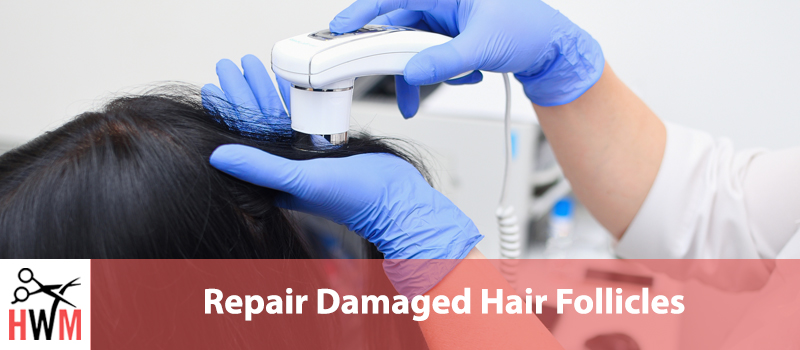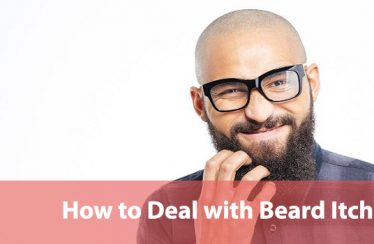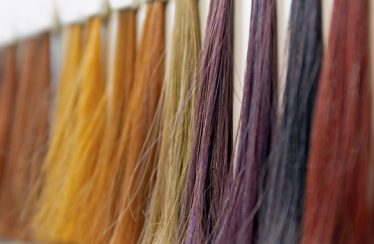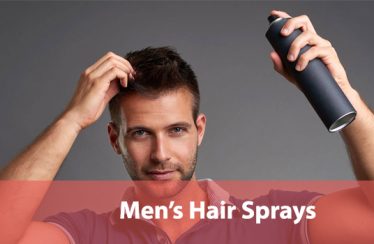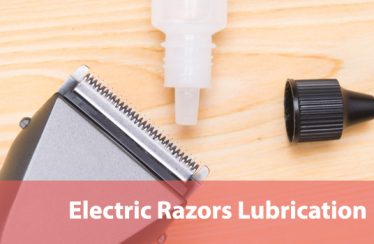If you’re looking to address your hair loss from the source of the damage up, hair follicles are a great place to start.
Just learning about how your hair follicles can get damaged doesn’t necessarily help. You need concrete solutions and ways to address the underlying problems. Having solutions is just as, if not more, important than understanding the problem.
Almost all hair loss involves hair follicle damage, so regardless of your particular form of hair loss, addressing follicle damage will help make your hair loss treatment more effective and will help restore more of your natural hair.
In this article, we’ll cover some hair follicle basics, including how they get damaged and one of the most important (and most common) forms of damage that can affect your hair. We’ll then go over some treatment options, how they work, and how long it will take to start seeing results.
How Hair Follicles Get Damaged
Your hair follicles are the literal root of all your hair, and one of the most important parts of maintaining a healthy mane.
But, they are deceptively easy to damage, despite being inside your skin. The wrong styling products, technique, or even simple environmental conditions can all cause damage to your hair follicles.
Under most circumstances, if your scalp is healthy and you have plenty of circulation getting to your hair follicles, the damage is temporary and can be healed like other tissue.
However, poor circulation, scar tissue, and consistent repetitive damage can cause permanent miniaturization or shrinkage of the hair follicle. If your hair follicles get too small, they stop being able to produce hair at all.
You might notice your hair follicles starting to shrink if your hair seems to become thinner (the individual strands, not your overall head of hair), changes texture significantly (sudden curls where you always had straight hair, looser or different curls, or hair that is suddenly straight), your hair seems whispy, frizzy, or seems to grow in already damaged.
Another sign of hair follicle damage is a widening part or more space between braids or cornrows. That extra space can be a sign of traction alopecia. Traction alopecia is a form of hair loss caused directly by too much constant pressure on your hair follicles.
Constant pulling leads to damage and a buildup of scar tissue. It’s reversible, but the longer you let it continue the less hair you’re likely to get back.
Damaged Dermal Papilla
Another common form of hair follicle damage, which can be caused by a number of issues with your scalp, is the hair follicle bulb, the very ‘bottom’ part of your hair follicle, disconnecting from the blood vessel that supplies nutrients, oxygen, and removes harmful chemicals and growth by-products.
The tiny blood vessels that do this important work are called dermal papilla.
Dermal papilla are small, easy to damage, and easily missed by your circulatory system if something is going wrong with your scalp or hair.
Most forms of hair thinning and hair loss are connected to damage to the dermal papilla. Traction alopecia, which we already mentioned, disconnects the dermal papilla thanks to constant tension and eventually the presence of scar tissue blocks the connections.
Androgenic alopecia also called male or female pattern baldness, the most common form of hair loss in men, involves damage to both the hair follicle itself and the dermal papilla by DHT and other hormones.
Androgenic alopecia is also often progressive and gets worse as you age.
But other forms of hair loss can also be connected to your dermal papilla, so it’s important to do everything you can to restore healthy circulation and maintain the connections between your hair follicles and your dermal papilla.
Restoring Hair Follicles
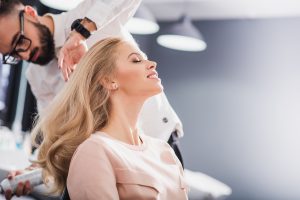
More important, in many cases, than knowing how your hair follicles got damaged in the first place, is knowing how you can help them heal and recover now.
Fortunately, there are lots of different ways you can help your follicles recover. Unfortunately, hair follicles are time-sensitive. The sooner you catch that you have hair follicle damage, the easier it will be to restore your hair to its former luster.
But, human hair has a long growth period, the different phases of hair growth can last months or even years, so even the quickest fixes require some patience and dedication if you want to see results.
Plan on sticking to any routine or treatment plan for at least six months before you evaluate whether or not the treatment is working.
You’ll likely start to see results as early as 3-4 months into your treatment plan, but you won’t see full results until the 6-12 month mark.
If you’re especially concerned, have advanced hair loss, or have other skin conditions that make treatment more difficult, you should consult with a dermatologist on any changes to your skin and hair care routines.
Nutrition is also vitally important to maintaining your hair and improving hair follicle health. If you’re serious about getting great results, you should also consider consulting a nutritionist and making a hair-supportive diet plan.
Skin Massage
Surprisingly, one of the most effective at-home treatments for hair loss is also one of the simplest.
Massage always brings more circulation to an area. It helps to break up and break down scar tissue and adhesive connections between cells.
While a scalp massage is by definition a skin massage, there isn’t much muscle to massage, after all, you’ll still reap the benefits from regularly massaging your scalp.
And no, this isn’t something you have to go to a massage therapist to receive.
A good scalp massage can be done at home, at night before bed, when you first wake up, in the shower, or any time you have five minutes to de-stress and tend to your scalp.
You can buy scalp massagers online, and they do make the job a little easier since all you have to do is apply a little pressure and move the massager in slow circles across your whole scalp. Look for a product with lots of soft tips, and don’t be afraid to pick up the massager to re-locate it without tangling in your hair.
The other, cheaper, option is just to use your fingertips. Avoid using your fingernails for this process since small abrasions on your scalp can also cause damage and negate the benefits of the scalp massage.
Move the pads of your fingers gently and slowly across your scalp in small circles. You should have enough pressure that the skin of your scalp moves with your fingertips, but not so much that it causes discomfort or pain.
You should also limit your scalp massage to once or twice a day. More that than and you risk causing irritation even with the pads of your fingers.
If you’re doing it right the motion should be relaxing and calming. Don’t be surprised if your scalp moves more freely over time, that’s the connective tissue under your skin, the fascia, loosening. Ultimately, loose, flexible, fluid fascia is great for circulation.
Don’t worry, no matter how loose your fascia gets, it won’t give your scalp a loose flabby skin look, and it might even help prevent wrinkles and other signs of aging.
All those benefits add up to healthy hair follicles. Better circulation is key, as is the flexibility in your scalp taking some pressure off your hair follicles when you style or wear your hair up.
Moisturizing
Moisturizing is another overlooked, but important part of maintaining scalp health.
The skin on your scalp isn’t that different from the skin on your face. It’s thinner, more delicate, and requires more attention than the skin elsewhere on your body.
Using the right shampoo, conditioner, and even other moisturizing products can make a huge difference in the overall health of your scalp and is important for hair follicle health.
Your hair follicles rely on your dermal papilla to provide what they need in terms of oxygen and nutrients, but they can also receive benefits from surface moisture and nutrients.
Shampoos and conditioners with argan oil have been particularly popular for maintaining and adding scalp moisture, recently, but they are far from the only option.
Look into a good conditioner. You should avoid sulfates and parabens (sulfate-free shampoos and conditioners are usually labeled) and look for ingredients like argan oil, coconut oil, shea butter, cetyl alcohol, and rosemary oil or extract.
The same rules apply to a good shampoo, but when it comes to moisturizing your conditioner is more important.
Avoid 2 in 1 shampoos and conditioners, since they often leave harsh cleansing chemicals on your hair and scalp in addition to the moisturizing and protective ingredients.
If you have a very dry scalp, dandruff, or other flaky itchy skin disorders you should also plan on using an anti-dandruff shampoo a couple of times a week. Anti-dandruff shampoos and conditioners that need to be used every day aren’t the best, but they are an option if you need them.
Try to use an additional conditioner if you use anti-dandruff products every day.
Cleansing
Just like moisturizing is important for your scalp so is keeping your scalp clean. And, like the skin on your face, your scalp benefits from a deeper, but gentler, clean than the rest of your body.
You should avoid cleansing shampoos. They do a great job keeping your hair and scalp clean, but they can be harsh and drying for both your hair and your skin.
Instead, focus on getting the shampoo you do use down to your scalp. You should make sure every section of your scalp gets some attention from the shampoo.
If you want to boost the cleansing power of your shampoo you can make a hair and scalp mask with tea tree oil and a carrier oil. Mint, rosemary, and even eucalyptus or lavender essential oils also have anti-microbial cleansing properties, although none of them should be applied to your head without a carrier oil to dilute them.
There are also some specialized scalp cleansers, of both the drugstore variety and from specialty brands like Nioxin. Scalp cleansers typically work with your shampoo and conditioner as an extra step in the shower.
If you buy a scalp cleanser you should follow the same rules as your shampoo and conditioner. Avoid sulfates and parabens and look for moisturizing ingredients.
You may also see good scalp cleansers marketed as scalp scrubs. Scrubs are another good option, but you should be careful to make sure you’re cleansing and not causing micro-scrapes and tears on your scalp.
The biggest problem with scrubs is that they can be too abrasive, and cause inflammation, increase your risk of affection, and even directly contribute to damaging your hair follicles.
Be gentle and pay attention to how your scalp feels during and after using a scrub. If your scalp feels raw, tight, or tense, you’ve probably either scrubbed too hard, or the product isn’t a great match for your skin.
You can also spray apple cider vinegar on your hair and scalp for a quick cleanser that also helps to condition your hair. Leave it on for at least 5 minutes before you rinse. You can also leave it in your hair, it won’t smell like vinegar after it dries.
Reducing Inflammation
Reducing inflammation is another important step to repair your damaged hair follicles. Avoiding styling gels, hair spray, and up-do hairstyles that hold your hair in an unnatural position for a long time.
If your hair is already thinning, especially if you have a widening part or thinning patches where you can easily see your scalp through your hair, you should use a sunscreen product to make sure you aren’t getting sunburns. Even if the irritation from sun exposure isn’t truly a burn it can increase inflammation and damage the hair follicles and skin cells in the area.
Inflammation in your scalp doesn’t tend to look or feel like inflammation in other parts of your body. It won’t just become slightly puffy or red. Instead, you’ll likely feel itchy or crawly sensations in your scalp. You might see pimples or other red spots, even scabbing.
Apple cider vinegar is also good for inflammation, soothing the causes of irritation and preventing yeast and bacteria overgrowth. Tea tree oil can also assist, although it still needs to be diluted in a carrier oil before being applied.
You should also experiment with washing your hair less often if you notice irritation and inflammation in your scalp. Neither your hair nor your scalp needs to be washed every day. Try cutting it down to once every other day, or once every third until you find a schedule that works for both your scalp and hair.
Avoid icing or trying other traditional methods for reducing inflammation on your scalp.
Ice decreases circulation and reducing the irritation and inflammation in your scalp requires circulation. You also need good circulation to avoid damaging your hair follicles further.
Using ice or other circulation reducing treatments will cause problems other than inflammation.
Improving Circulation
We’ve already mentioned how important circulation is for the health of your hair follicles, so making sure your scalp is getting plenty of circulation is critical for restoring your hair.
Treating the sources of irritation will help improve circulation by making your skin less inflamed, better nourished, and easier for blood to flow through.
Many of the treatments we’ve recommended for other scalp problems will naturally work to increase scalp circulation. Tea tree oil, mint, eucalyptus, and other essential oil treatments also increase circulation. So will apple cider vinegar. You can also combine the two by adding a couple of drops of your essential oil of choice to a spray bottle full of vinegar.
Scalp massage’s primary function is to improve circulation.
You can also start working out or add a cardio routine to your existing workout. Improving your overall health, circulatory health, and heart health will naturally increase the circulation to your scalp since your blood vessels widen and your heart gets stronger when you exercise.
Yoga, inversion tables, and other positions that have your head down also increase the circulation in that area. Over time your blood vessels will widen naturally to accommodate the additional blood in the area.
Treatment Options
Naturally, restoring your damaged hair follicles isn’t all at-home remedies and lifestyle changes. Since hair follicle health is at the root of most forms of hair loss, traditional hair loss treatments often work to protect, preserve, and improve the health of your hair follicles.
These treatment options are all only effective so long as you continue using them. Since they don’t cause significant physiological changes in your skin or other body processes, they simply intervene in negative process patterns, the damage will return as soon as you stop treatment.
Usually, your most effective option will be to combine these treatments with some of the at-home changes and interventions that we’ve already listed.
Of course, if you are concerned about a treatment, or combining one treatment with others, you should consult with a doctor or dermatologist.
Topical Treatments
Many treatments for hair loss and hair follicle damage are topical, just like that at-home remedies we’ve already discussed.
Shampoos
Hair loss shampoos are incredibly common and tend to treat one or more of the most common causes of hair follicle damage.
Almost no shampoos are FDA approved as effective hair loss treatments, but many are anecdotally supported as effective for a large percentage of their users.
Look for bottles that specialize in hair loss. They’re typically a little more expensive, and you may need to go to a specialty beauty store to have much selection. On the bottle they should mention fighting or blocking DHT, reducing inflammation, and moisturizing as target areas for the shampoo.
They usually also have several botanical ingredients like tea tree oil, mint extract, saw palmetto, and other natural oils. Biotin and D vitamins are also common additives, all of which have a cumulative beneficial effect on your hair.
Rogaine/Minoxidil
The only FDA approved topical treatment for hair loss, Minoxidil works to bring additional circulation to your hair follicles.
It’s more effective than simply increasing circulation for many users, but the other mechanisms for improving hair growth aren’t entirely understood.
Rogaine and generic minoxidil both take 3-4 months to show results, and you won’t see full results for 6-12 months. If you stop using minoxidil products the hair you have as a result of the minoxidil will fall out within 6 months.
Red Light Therapy
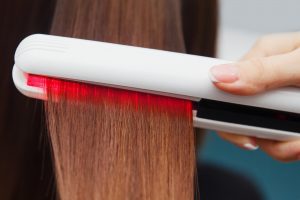
Red light therapy is another option if you’re looking for an alternative intervention to improve your hair follicle health.
It hasn’t been studied for hair loss specifically, but it has been shown to reduce inflammation and generate many positive effects for joint health and skin health in general.
Red light therapy is thought to increase the amount of ATP, the basic unit of energy used by all cells, produced in your skin.
When it’s used in skin treatments it helps increase collagen production along with a host of other positive effects. Since your hair follicles are part of your skin, improving overall skin health should also improve the health of your hair follicles and give your follicles the energy to heal more completely.
Supplements
Another option is to start taking supplements to treat the causes of hair follicle damage. Increasing circulation, increasing the necessary nutrients available in your bloodstream, and adaptogens that help your body handle stress without some of the negative side effects.
Biotin or Hair Skin and Nails
Hair skin and nails supplements are usually a combination of biotin and vitamin C, sometimes along with zinc, botanicals, or other less important active ingredients.
Biotin is one of the B vitamins and is water-soluble so it’s usually very safe to take since your body can easily eliminate any excess vitamin.
Zinc
Zinc is another crucial vitamin for hair health. It helps promote circulation as well and supporting positive hair growth.
Multivitamins
A good multivitamin contains an assortment of vitamins critical for hair growth as well as supporting your overall health. Usually, they’ll contain vitamin C, an assortment of B vitamins, vitamin D, iron, magnesium, and calcium.
Additional vitamins can also help, but you should also know that supplements are not well regulated, so the quality and content of a supplement may not exactly match what they advertise.
If you’re concerned about a vitamin’s quality or health benefits you can ask your doctor if there is a brand they recommend, although even a doctor’s recommendation is based on their anecdotal experience as much as testing and quality results.
Conclusion
Your hair follicles can be a great indicator of your overall health, and the things you do to improve the health of your hair follicles often help you look and feel healthier.
Some simple adjustments to your routine, and treatments for your hair and scalp, and you’ll be well on your way to happier, healthier hair follicles.
Contents
